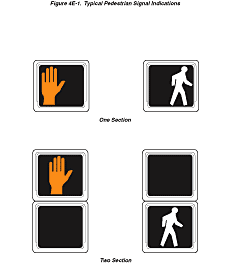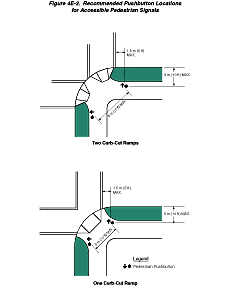|
|
Chapter 4E. Pedestrian Control Features
Section 4E.01 Pedestrian Signal
Heads
Support: Guidance:
Section
4E.02 Meaning of Pedestrian Signal Head Indications
Standard: A.
A steady WALKING PERSON (symbolizing WALK) signal
indication means that a pedestrian facing the signal indication is permitted
to start to cross the roadway in the direction of the signal indication,
possibly in conflict with turning vehicles. The pedestrian shall yield the
right-of-way to vehicles lawfully within the intersection at the time that
the WALKING PERSON (symbolizing WALK) signal indication is first shown. B.
A flashing UPRAISED HAND (symbolizing DONT WALK) signal
indication means that a pedestrian shall not start to cross the roadway in
the direction of the signal indication, but that any pedestrian who has
already started to cross on a steady WALKING PERSON (symbolizing WALK) signal
indication shall proceed out of the traveled way. C.
A steady UPRAISED HAND (symbolizing DONT WALK) signal indication means that a pedestrian shall not enter
the roadway in the direction of the signal indication. D.
A flashing WALKING PERSON (symbolizing WALK) signal
indication has no meaning and shall not be used. Section
4E.03 Application of Pedestrian Signal Heads
Standard: A.
If a traffic control signal is justified by an engineering
study and meets either Warrant 4, Pedestrian Volume or Warrant 5, School
Crossing (see Chapter
4C); B.
If an exclusive signal phase is provided or made available
for pedestrian movements in one or more directions, with all conflicting
vehicular movements being stopped; or C.
At an established school crossing at any signalized
location. D.
Where engineering judgment determines that multiphase
signal indications (as with split-phase timing) would tend to confuse or
cause conflicts with pedestrians using a crosswalk guided only by vehicular
signal indications. Guidance: A.
If
it is necessary to assist pedestrians in making a reasonably safe crossing or
if engineering judgment determines that pedestrian signal heads are justified
to minimize vehicle-pedestrian conflicts; B.
If
pedestrians are permitted to cross a portion of a street, such as to or from
a median of sufficient width for pedestrians to wait, during a particular
interval but are not permitted to cross the remainder of the street during
any part of the same interval; and/or C.
If
no vehicular signal indications are visible to pedestrians, or if the
vehicular signal indications that are visible to pedestrians starting or
continuing a crossing provide insufficient guidance for them to decide when
it is reasonably safe to cross, such as on one-way streets, at
T-intersections, or at multiphase signal operations. Section
4E.04 Size, Design, and Illumination of Pedestrian
Signal Head Indications
Standard:
Figure 4E-1 Typical Pedestrian
Signal Indications
The
UPRAISED HAND (symbolizing DONT WALK) signal section shall be mounted
directly above or integral with the WALKING PERSON (symbolizing WALK) signal
section. The WALKING
PERSON (symbolizing WALK) signal indication shall be white, conforming to the
publication entitled "Pedestrian Traffic Control Signal
Indications" (see Section
1A.11), with all except the symbol obscured by an opaque material. The
UPRAISED HAND (symbolizing DONT WALK) signal indication shall be When not
illuminated, the WALKING PERSON (symbolizing WALK) and UPRAISED HAND
(symbolizing DONT WALK) symbols shall not be readily visible to pedestrians
at the far end of the crosswalk that the pedestrian signal head indications
control. For
pedestrian signal head indications, the symbols shall be at least 150 mm (6
in) high. The light
source of a flashing UPRAISED HAND (symbolizing DONT WALK) signal indication
shall be flashed continuously at a rate of not less than 50 nor more than 60
times per minute. The illuminated period of each flash shall be not less than
half and not more than two-thirds of the total flash cycle. Guidance:
For
crosswalks where the pedestrian enters the crosswalk more than 30 m (100 ft)
from the pedestrian signal head indications, the symbols should be at least
225 mm (9 in) high. Option: Standard:
Section
4E.05 Location and Height of Pedestrian Signal Heads
Standard: If
pedestrian signal heads are mounted on the same support as vehicular signal
heads, there shall be a physical separation between them. Section
4E.06 Accessible Pedestrian Signals
Support: Guidance: Support: Local
organizations, providing support services to pedestrians who have visual and/or
hearing disabilities, can often act as important advisors to the traffic
engineer when consideration is being given to the installation of devices to
assist such pedestrians. Additionally, orientation and mobility specialists
or similar staff also might be able to provide a wide range of advice. The
U.S. Access Board’s Document A-37, “Accessible Pedestrian
Signals,” provides various techniques for making pedestrian signal
information available to persons with visual disabilities (see Addresses
for the address for the U.S. Access Board). Accessible
pedestrian signals provide information in nonvisual
format (such as audible tones, verbal messages, and/or vibrating surfaces). Information
regarding detectors for accessible pedestrian signals is found in Section 4E.09. Standard: Under
stop-and-go operation, accessible pedestrian signals shall not be limited in
operation by the time of day or day of week. Guidance: A.
Potential
demand for accessible pedestrian signals; B.
A
request for accessible pedestrian signals; C.
Traffic
volumes during times when pedestrians might be present, including periods of
low traffic volumes or high turn-on-red volumes; D.
The
complexity of traffic signal phasing; and E.
The
complexity of intersection geometry. Support: Standard: Guidance: A.
Where
there is an island that allows unsignalized right
turns across a crosswalk between the island and the sidewalk. B.
Where
multileg approaches or complex signal phasing
require more than two pedestrian phases, such that it might be unclear which
crosswalk is served by each audible tone. C.
At
intersections where a diagonal pedestrian crossing is allowed, or where one
street receives a WALKING PERSON (symbolizing WALK) signal indication
simultaneously with another street. Standard: Support: Guidance: Automatic
volume adjustment in response to ambient traffic sound level should be
provided up to a maximum volume of 89 dBA. Where
automatic volume adjustment is used, tones should be no more than 5 dBA louder than ambient sound. The A-weighted sound
pressure level should conform to the requirements of “ISO
1996-1:1982” and “ISO 1996-2:1987” (see Addresses
for the address for the International Organization for Standards). Standard: The verbal
message that is provided at regular intervals throughout the timing of the
walk interval shall be the term "walk sign," which may be followed
by the name of the street to be crossed. A verbal
message is not required at times when the walk interval is not timing, but,
if provided: A.
It shall be the term "wait." B.
It need not be repeated for the entire time that the walk
interval is not timing. Option: Support: Standard: Guidance: Section
4E.07 Countdown Pedestrian Signals
Option: Standard: If used,
the display of the number of remaining seconds shall begin only at the
beginning of the pedestrian change interval. After the countdown displays
zero, the display shall remain dark until the beginning of the next
countdown. If used,
the countdown pedestrian signal shall display the number of seconds remaining
until the termination of the pedestrian change interval. Countdown displays
shall not be used during the walk interval nor
during the yellow change interval of a concurrent vehicular phase. Guidance: For
crosswalks where the pedestrian enters the crosswalk more than 30 m (100 ft)
from the countdown pedestrian signal display, the numbers should be at least
225 mm (9 in) in height. Because
some technology includes the countdown pedestrian signal logic in a separate
timing device that is independent of the timing in the traffic signal
controller, care should be excercised by the
engineer when timing changes are made to pedestrian change intervals. If the
pedestrian change interval is interrupted or shortened as a part of a
transition into a preemption sequence (see Section
4E.10), the countdown pedestrian signal display should be discontinued
and go dark immediately upon activation of the preemption transition. Section
4E.08 Pedestrian Detectors
Guidance: Standard: Option: Guidance: Standard: Guidance: A mounting
height of approximately 1.1 m (3.5 ft) above the sidewalk should be used for
pedestrian pushbutton detectors. If used,
special purpose pushbuttons (to be operated only by authorized persons)
should include a housing capable of being locked to
prevent access by the general public and do not need an instructional sign. Standard: Option: Section
4E.09 Accessible Pedestrian Signal Detectors
Standard: At
accessible pedestrian signal locations with pedestrian actuation, each
pushbutton shall activate both the walk interval and the accessible
pedestrian signals. Option: Pushbutton
locator tones may be used with accessible pedestrian signals. Guidance: Pushbuttons
for accessible pedestrian signals should be located (see Figure 4E-2) as
follows: A.
Adjacent
to a level all-weather surface to provide access from a wheelchair, and where
there is an all-weather surface, wheelchair accessible route to the ramp; B.
Within
1.5 m (5 ft) of the crosswalk extended; C.
Within
3 m (10 ft) of the edge of the curb, shoulder, or pavement; and D.
Parallel
to the crosswalk to be used. Figure 4E-2 Recommended
Pushbutton Locations for Accessible Pedestrian Signals
If the
pedestrian clearance time is sufficient only to cross from the curb or
shoulder to a median of sufficient width for pedestrians to wait and accessible
pedestrian detectors are used, an additional accessible pedestrian detector
should be provided in the median. Standard: Guidance: Pushbutton
locator tones should be deactivated during flashing operation of the traffic
control signal. Option: The audible
tone(s) may be made louder (up to a maximum of 89 dBA)
by holding down the pushbutton for a minimum of 3 seconds. The louder audible
tone(s) may also alternate back and forth across the crosswalk, thus
providing optimal directional information. The name of
the street to be crossed may also be provided in accessible format, such as
Braille or raised print. Section
4E.10 Pedestrian Intervals and Signal Phases
Standard: A
pedestrian clearance time shall begin immediately following the WALKING
PERSON (symbolizing WALK) signal indication. The first portion of the
pedestrian clearance time shall consist of a pedestrian change interval
during which a flashing UPRAISED HAND (symbolizing DONT WALK) signal
indication shall be displayed. The remaining portions shall consist of the
yellow change interval and any red clearance interval (prior to a conflicting
green being displayed), during which a flashing or steady UPRAISED HAND
(symbolizing DONT WALK) signal indication shall be displayed. If countdown
pedestrian signals are used, a steady UPRAISED HAND (symbolizing DONT WALK) signal indication shall be displayed during the yellow
change interval and any red clearance interval (prior to a conflicting green
being displayed) (see Section 4E.07). At
intersections equipped with pedestrian signal heads, the pedestrian signal
indications shall be displayed except when the vehicular traffic control
signal is being operated in the flashing mode. At those times, the pedestrian
signal lenses shall not be illuminated. Guidance: Option: Support: Guidance: Option: Guidance: Option: On a street
with a median of sufficient width for pedestrians to wait, a pedestrian
clearance time that allows the pedestrian to cross only from the curb or
shoulder to the median may be provided. During the
transition into preemption, the walk interval and the pedestrian change
interval may be shortened or omitted as described in Section
4D.13. |


